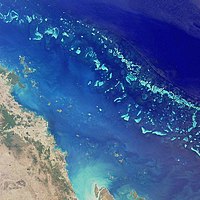
Photo from wikipedia
Abstract Applying the ecological resilience principles to barrier island geomorphological evolution requires approaches that perceive and interpret resilience far from predefined barrier characteristics and static views. Accepting that barrier islands,… Click to show full abstract
Abstract Applying the ecological resilience principles to barrier island geomorphological evolution requires approaches that perceive and interpret resilience far from predefined barrier characteristics and static views. Accepting that barrier islands, like all natural systems, are dynamic and adaptively changing in response to external disturbances is fundamental to the formulated approach. To this aim, geomorphological units and dimensions were used to describe barrier island stability landscape as an actively shifting ‘topography’, reshaping in response to exogenous events and in relation to intrinsic properties. The structure of the subaerial barrier was characterised using the environmental units of Beach, Dune and Marsh (or BDM), where different combinations of BDM structure define distinct barrier stable states, under a simplified framework that is applicable over a wide range of barrier structures. The methodology is based on reconstructing resilience trajectories of barrier islands through identifying the distinct BDM states and related shifts (thresholds crossed) and assessing resilience dimensions (latitude, resistance and precariousness defined as barrier width and height and proximity to mainland, respectively) that, jointly, define the shape of the stability domain. The approach was applied to the Ria Formosa barrier island system (S. Portugal), using multi-decadal geomorphological data and gradually decreasing spatial discretisation, passing from individual barrier transects to sectors and to entire barriers. The joint evolution of two inland-migrating barriers (Cabanas Island and Cacela Peninsula) was used as an exemplar of adaptive capacity in barrier geomorphic change and, therefore, of resilient response to external pressures. Resilience pathways showed that the Ria Formosa barriers have been resilient over the studied timeframe, with a tendency for maintaining or increasing BDM structural complexity. In general, the stability domain tends to shift from low latitude and high resistance forms (narrow-deep basins of attraction) in the west part of the barrier chain, to higher latitudes and lower resistance ones (wide-shallow basins) towards the east. Precariousness peaks near the edges of the system (low lagoon width) and minimises towards the central part (most detached barriers). Scaling issues regarding smoothing of longshore variability and potential consequences on masking thresholds and critical dimensions are highlighted and discussed, along with the key role of the meaning of specified resilience (of what?) in the assessment. The methodology is a novel approach, easily transferable to different systems and spatiotemporal scales of analysis, representing a step forward in interpreting and assessing barrier island resilience.
Journal Title: Catena
Year Published: 2020
Link to full text (if available)
Share on Social Media: Sign Up to like & get
recommendations!